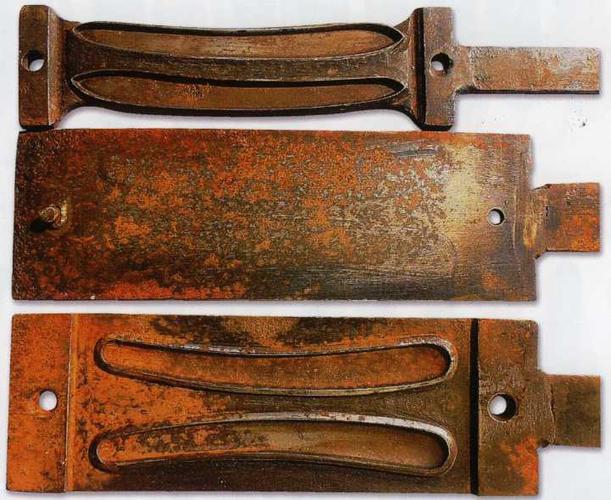Results 11 to 17 of 17
Thread: Hot Pressed Horn Repair?
-
02-16-2013, 05:50 PM #11The First Cut is the Deepest!


- Join Date
- Feb 2010
- Location
- Upper Middle Slobovia NY
- Posts
- 2,736
Thanked: 480
Plus many times over for being cautious with steam. I know a fella who's brother was a steam fitter. and yes, I am using the past tense. what a horrible way to go.
Let us never ignore safety in our pursuit of knowledge!
-
02-20-2013, 08:22 AM #12Senior Member



- Join Date
- Apr 2008
- Location
- Essex, UK
- Posts
- 3,816
Thanked: 3164
Originally, the horn (when rendered soft by boiling) was put into a cast iron mould that both shaped and impressed a pattern (if required) into the horn. For just one pair of scales a three piece mould was used: top and bottom plate and shaper plate, the top and bottom having lugs to enable the mould to be tightly bolted together.
The whole mould was heated to a high temp., and heavily greased with tallow. The mould was then bolted down tight, so any keratin that flowed was contained and the inherent layers compressed. A number of these forms were stacked, and often covered over to retain the heat. Steaming was not used in this particular branch of the horn trade, nor in the allied branch that flattened and split horn into sheets used to glaze oil-lamps (lant-horn = mod. lantern) or glaze small window openings.
Regards,
Neil
-
The Following 4 Users Say Thank You to Neil Miller For This Useful Post:
Geezer (02-23-2013), Lemur (02-20-2013), Magpie (02-23-2013), regularjoe (02-23-2013)
-
02-20-2013, 09:19 AM #13

Do you happen to know what temp the mold would have to be heated to? I think I might have to mess around with this one of these days. Sounds like fun.
-
02-20-2013, 10:14 AM #14Senior Member



- Join Date
- Apr 2008
- Location
- Essex, UK
- Posts
- 3,816
Thanked: 3164
Boiling in water was a prolonged process - anywhere from 1 to 2 hours.
Boiling in water will get you to around 212 degrees, the mould-press should be around 300 - 350 degrees. To give you some idea of the force needed to crank down the press, in the mid 1700s it would take two men turning a bar.
If you forget the tallow, the horn will stick to the mould.
Later processes involve putting the horn in the press, then heating the whole thing while cranking it - this was said to give a more precise, sharper rendering of the pattern. I have seen pictures of simple cast iron scale moulds, but never the intricately carved ones - must be some out there somewhere!
Regards,
Neil
-
The Following 4 Users Say Thank You to Neil Miller For This Useful Post:
Geezer (02-23-2013), JSmith1983 (02-20-2013), Lemur (02-20-2013), Magpie (02-23-2013)
-
02-20-2013, 02:17 PM #15

I know that among people working with restoration of horn/bone, this is considered a "bible"; Amazon.com: Bone, antler, ivory & horn: The technology of skeletal materials since the Roman period (9780389205319): Arthur MacGregor: Books
Hur Svenska stålet biter kom låt oss pröfva på.
-
The Following 2 Users Say Thank You to Lemur For This Useful Post:
Geezer (02-23-2013), regularjoe (02-23-2013)
-
02-23-2013, 12:47 AM #16

This link may be of service:
http://is.gd/mp1n09
~Richard
-
The Following 6 Users Say Thank You to Geezer For This Useful Post:
JSmith1983 (02-23-2013), Lemur (02-23-2013), Magpie (02-23-2013), Martin103 (03-23-2016), regularjoe (02-23-2013), Tarkus (02-23-2013)
-
02-23-2013, 12:04 PM #17Senior Member



- Join Date
- Apr 2008
- Location
- Essex, UK
- Posts
- 3,816
Thanked: 3164
Here's a pic from an excellent french book - Rasoir a Droit - that shows a later version of the press. I doubt that they changed much over the years, though:

BTW, I work with a lot of old razors and when the blade is being re-pinned you can often open the scales and see the horn-pressers or plate-makers initials on the inner surface of the scale. Sometimes they look crude and scratched on, sometimes they had been delicately carved into the steel. A wade and Butcher I was working on a few days ago had a very neatly inscribed 'W*F" on it. Echoes of a long dead hand and a part of history that we don't know enough about.
Regards,
Neil
-
The Following 5 Users Say Thank You to Neil Miller For This Useful Post:
Geezer (02-23-2013), jamesm (02-25-2013), Lemur (02-24-2013), regularjoe (02-23-2013), Tarkus (02-23-2013)


 22Likes
22Likes LinkBack URL
LinkBack URL About LinkBacks
About LinkBacks






 Reply With Quote
Reply With Quote


